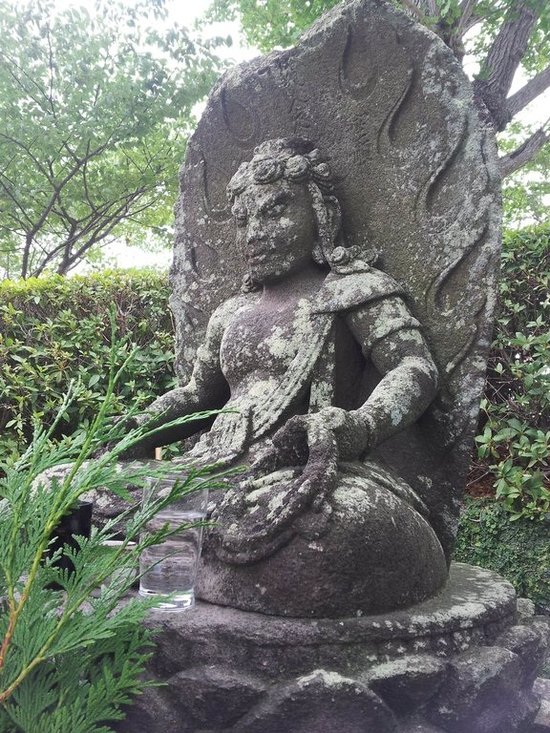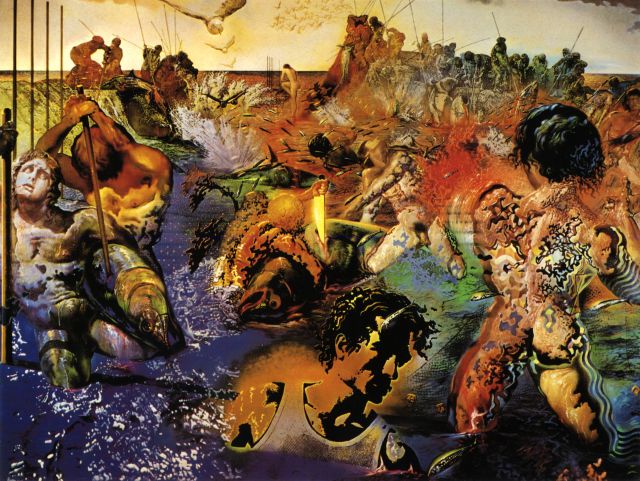|
estebanana -> RE: Dispatches from Akune (May 28 2013 4:32:26)
|
4~ When the Jaded Write Guidebooks
Looking out my back window I can see the Shinto fire prevention deity in the park. The rainy season has just begun. In the last week anonymous offerings have appearing in front of the stone, glasses and cups full of water, bouquets of store bought flowers. Yoshimori was born in Akune, he’s nearing eighty, but looks about sixty five. A group of Akuneans did a short ceremony at the deity site this week. I saw them from the back window, Yoshimori included. It was mainly older people, Akune is an old town, I mean mostly populated by those over sixty as all the young people tend to move out to Osaka or Tokyo seeking employment. There are kids here, lots of them and younger couples, but you see more old people in the streets during the day. At the bus stop after school kindergarteners wait for moms to pick them up. They wait by doing homework, spilling the contents of their book bags on the sidewalk and excitedly finger pointing at shared answers.
The kids wear “kid uniforms” and all the old people wear “old people uniforms". The ages in between just look confused, like they are displaced out of a big city and landed in Akune for no reason. Grandma uniforms are house dresses with either cloth or plastic aprons, depending on what they are doing. Old guy uniforms are wind breakers and drab lose trousers, and wide brimmed straw hats if going fishing. Most of the young guys wear ball caps for fishing, they almost have a uniform together, but still look out of place.
The crowd at the Shinto shrine was in shirt sleeves with the requisite drab trousers, but most were looking natty with shirts tucked in like school boys, even though the average age was about seventy two. The few ladies present took off aprons in favor of knit sweaters or a long kimonoish light coat. Yoshimori told me the mystery offerings probably appeared because there was a small fire in town recently and the person who felt responsible for it probably stepped forward to leave secret offerings of water because they felt guilty. It could have been someone leaving a mess of paper trash in the garage and an electrical cord sparked and set a fire, or any accident, but he thinks someone felt bad and began the new round robin of offerings at the shrine.
The deity is called Hinokamisama and he been there since about 1635. The town has grown around the sculpture and the park has seen many uses during the time he’s been sitting on his lotus pad chair. Before the area behind the house was a park it was a cemetery, they must have moved all the bodies because the kids’ massive play structures, slides, monkey bars, etc. are all rooted in deep cement foundations and would intrude upon the resting level of the dead if they were still there. Not to mention the screaming elementary school brats and skate borders that I can hear in the afternoons. The little sliders and swingers’ screeching would undo the dead and the curb scraping board breaking skaters would finish them off. Poor dead. Good thing they migrated long ago to the Buddhist temple mortuary storage cabinets.
Hinokamisama gave those old boys and girls of the Honmachi district a good reason to get together to drink shochu. Shochu is a distilled beverage made of sweet potatoes and is native to Kyushu, yeah the Koreans, Chinese and other island nations make claim to shochu, but it is the product of the Kyushuians from way back. Akune like all towns and cities in Japan is made up of small districts, they don’t give streets names in Japan, but send mail by directing it to the proper district in town and the post man knows the name of the person and where they live or he goes by a house or building number. It’s kind of odd and it reminds me of the U-2 album with the song “Where the streets have no name”. That song was written in Joshua Tree California, but it applies here as well. Some of the twenty plus folks standing in front of old Hinokamisama were gripping beaded & tassled wrist bands which are a “Buddhist prayer rosary” for lack of a better way to explain the object. Many of them were not from Honmachi, but from other districts in Akune where the streets also have no names. There was a paid Shinto priest officiating and everyone made the proper bows and gasshos on que as he recited various chants. Gassho is the gesture of putting ones hands palms facing together in front of ones chest and holding the gesture for a few seconds in reverent peacefulness. Gassho is exactly the same gesture that Christians make when praying, which makes you wonder about the origins of religion. If all the religions use the same gesture maybe the game is afoot, as Sherlock Holmes would say, but the mystery of why religions fight remains a mystery. Shintoism is the main religion in Japan, but it’s pretty much like everywhere else in the world. You have some religion enthusiasts who make religion a big deal, but most people take religiosity in moderate amounts. It’s like drinking the shochu, too much will give a bad day tomorrow.
I went to a shochu distillery a few weeks back, there’s one in another district of Akune about a 20 minute walk from Honmachi. I can’t remember how to get there, because I have not gotten used to the concept of streets without names. However I can almost navigate by alcoholic beverage global positioning, ABGP. Maybe there's a joke in there about Dead Reckoning, but it would be too obvious to tell, and have a flat rhumb line or two. My dad and my uncles used to drive around in San Bernardino, the town I was born in, winding their way from one end of town to the other by on side streets by using the liquor stores as positioning markers. You could give directions to a guy in San Bernardino by telling them to drive past the Elgin Fagan bar, turn left on Highland Ave and go down past Heywood’s Ice Cream and then go up Sierra Way past the Monkeys Hide Out bar and to grandmothers house you go. Wait, I’m sorry, I just got you lost. The Monkey’s Hideout is down near Valley College. It’s all very murky to me because I was not actually drinking at the time, being a child, wearing a child’s uniform in the back seat of the car. Heywood’s Ice Cream was more my monument for reference in childhood. Mr. Heywood built balsa wood model airplanes, I remember them hanging from the ceiling of the ice cream parlor. There were crop dusting biplanes covered with seamless bright blue and yellow tissue papers. He made olive green WWII fighter planes and scarlet red Piper Cubs. Maybe there was a Mitsubishi Zero with a big orange meatball on the fuselage. The counter was long and high, the stools were covered in slick sparkly vinyl that stuck to little boys shorts wearing legs in summer and the ice cream tasted much better than beer. I tripped and dropped my cone on the floor once and they gave me a whole new one. That still does not help me locate that shochu making factory. I’ll have to ask directions to visit them again in the late summer to early fall when the big sweet potato crop comes in and they begin the season of shochu making.
On Kyushu, in the south, they drink shochu mixed with straight hot water. No matter whether it’s the typhoon season or the dry season the dudes who wear the old guy uniforms universally drink shochu in a water glass with the ideal ratio of 7 to 3 water to shochu, or also acceptable is 6/4. Much debate can arise as to whether a particular person should be 6/4 or a 7/3 person depending on size and constitution. Throw a big gaijin like me into that equation and they have a field day discussing the proper ratio a newcomer should try. At first I was dubious and drank the shochu on ice, it’s good, but soon I succumbed to the hot water method. It’s much easier to tell the truth. For shochu on ice one must get up from the table and walk into the kitchen and take ice from the freezer, put it in your glass, walk back to the table, reseat yourself on the floor and then pour the shochu over the ice. Geeze, it’s too much work in the heat. Best thing to do is hand your glass to the person nearest the ever present push top hot water dispensing thermos that is ubiquitous to Japanese sitting and dining rooms and ask them to fill your glass with water for shochu. In fact the nearest person does not really need to be asked or told the proper ratio of water to shochu. They will automatically size up your glass and shoot the local Kyushu prescribed amount of H2o in your glass and hand it back. No need to get up and open the fridge, just imbibe hot like the natives. Ice does have its place in shochu cocktails, delicious mixtures of plum wine or fruit juices with soda water and shochu, mostly ladies drink them, but I like them too. However the real man drinks schochu with hot water in the correct ratio, unless the locals are trying to get you drunk to see how much shochu you can drink. I was given glasses with as much as half and half shochu to water at a party recently, and one recalcitrant fisherman by the name of Yuzo gave me a glass with straight shochu. Afterwards that party was to be dubbed “The party with one thousand legs” at some point in the future I’ll write about that one, but it was over three weeks ago and I still have trouble remembering my name much less the no name street it took place on.
The party in the park for the recognition of the fire deity Hino-what’s is name sama completed the gasshos and paid the Shinto priest his due. They walked en masse’ to the Honmachi cultural center a few blocks away for a bento dinner and no doubt some shochu and hot water. The Honmachi cultural center is an old building; some Honmachians think it’s not as good as the other districts meeting halls. Each district has a performance/town meeting hall that can be rented for weddings, concerts or funeral events. But it makes me wonder how those from other districts or out of towners find the damn things because the streets have no names.
I was really, really trying tell you about the incoming rainy season, but got distracted. It’s mid afternoon and shochu time is not officially until after dinner, but it’s always 6 o’clock somewhere. Just have to get up and make hot water.

Images are resized automatically to a maximum width of 800px
|
|
|
|



